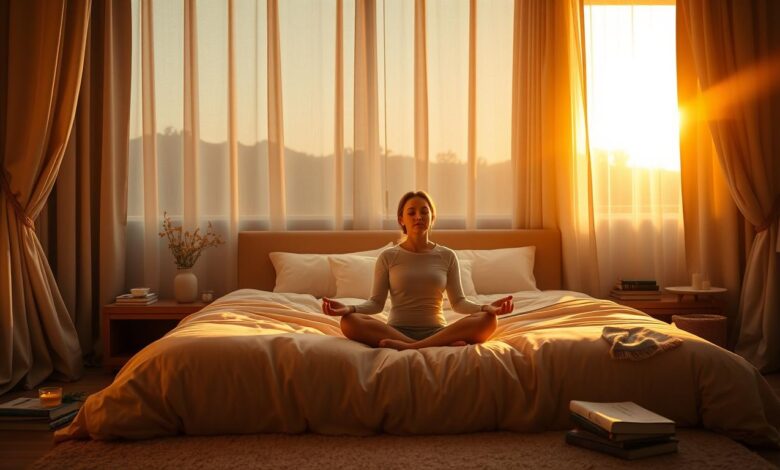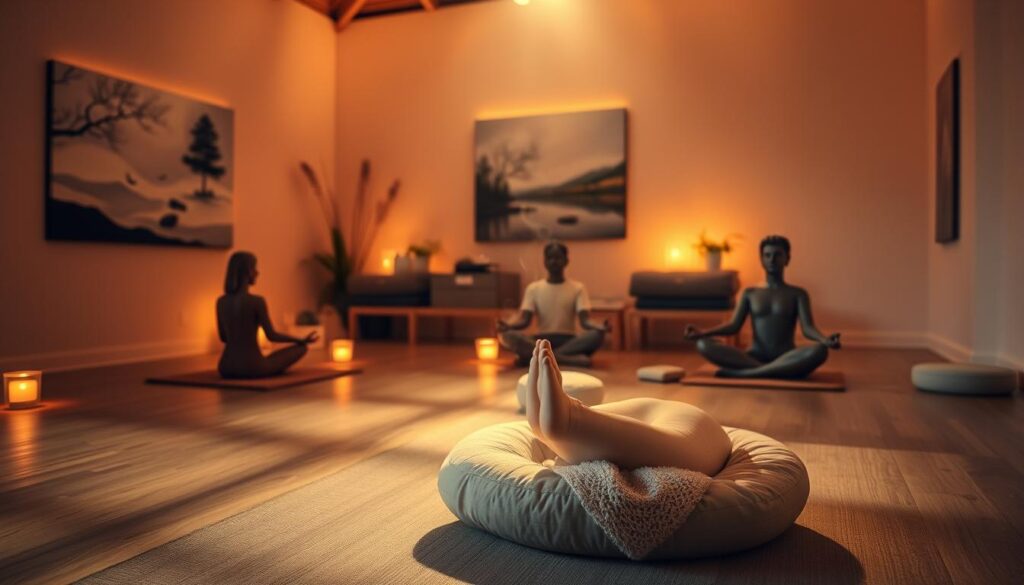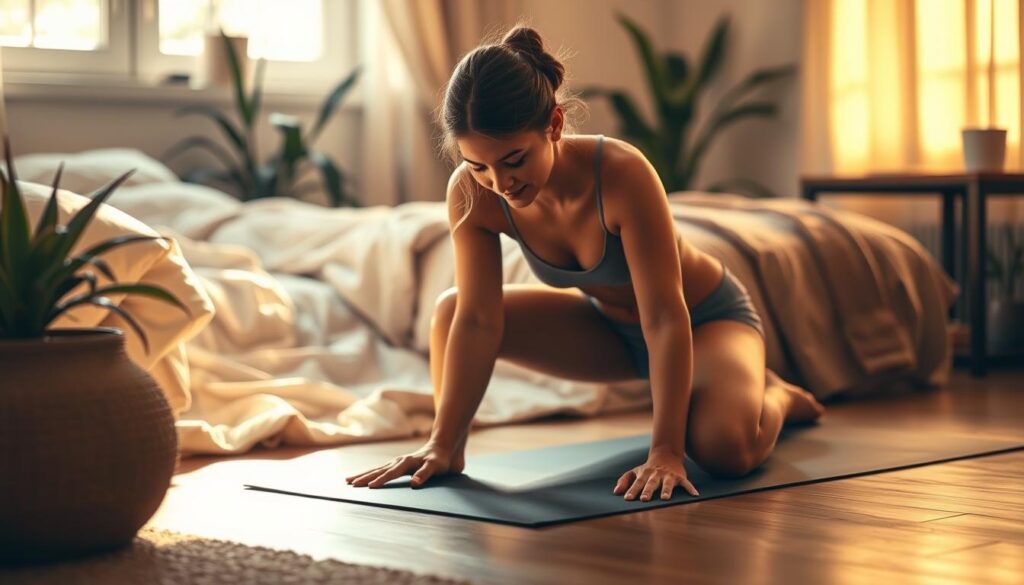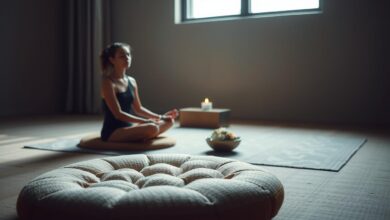Unlock Restful Sleep with These Proven Relaxation Tips

Have you ever lain awake, counting sheep while the clock ticks past midnight? You’re not alone. Millions of Americans struggle with restless nights, leaving mornings filled with fatigue instead of energy. What if you could quiet that racing mind and let your body unwind? This guide is your roadmap to better sleep, using relaxation techniques for sleep that are backed by science and designed for real life.
Key Takeaways
- Relaxation techniques for sleep can reduce insomnia and improve sleep duration.
- Science-backed methods like breathing exercises and visualization are easy to practice at home.
- Small changes to your bedtime routine can lead to long-term sleep improvements.
- Over 1 in 3 adults report poor sleep, but these strategies address both mind and body.
- You can start improving sleep quality tonight with simple, proven techniques.
Understanding Sleep and Its Importance
Learning about sleep is key to better rest. Start with understanding your body’s natural sleep patterns. Let’s dive into what happens when you sleep.
The Sleep Cycle Explained
- Stage 1 (Light Sleep): Your muscles relax, and brain waves slow.
- Stage 2: Body temperature drops, preparing for deeper phases.
- Stage 3 (Deep Sleep): Tissue repair and immune support occur here.
- REM Sleep: Dreams happen, aiding memory and emotional regulation.
“Sleep is your body’s reset button—don’t skip its nightly recharge.”
Health Benefits of Quality Sleep
Your immune system strengthens, and brain fog lifts with good sleep habits. Studies show that regular sleep:
- Boosts focus and problem-solving skills
- Reduces stress hormones like cortisol
- Helps maintain a healthy weight by regulating hunger hormones
Ignoring sleep harms more than just energy levels—it’s vital for your health. Small changes now can lead to big improvements later.
Common Causes of Sleep Issues
Many Americans struggle with sleep due to hidden stress and daily routines that disrupt natural sleep patterns. Knowing these barriers is key to tackling them with sleep-inducing practices.
Stress and Anxiety’s Role
Stress can make bedtime a time of restlessness. High levels of cortisol, a stress hormone, keep your mind awake. The fight-or-flight response makes it hard to relax and sleep.
“Anxiety disorders affect 40% of poor sleep cases, per the National Sleep Foundation.”
Lifestyle Factors Impacting Sleep
Small habits can quietly ruin your sleep:
| Factor | Impact |
|---|---|
| Caffeine after 2 PM | Blocks adenosine, delaying sleep onset |
| Blue light exposure | Reduces melatonin production by 22%, per Harvard studies |
| Irregular wake times | Disrupts circadian rhythm, causing insomnia |
| Heavy evening meals | Activates digestion, increasing nighttime discomfort |
Changing these habits can help you find sleep-inducing practices that align with your body’s needs.
Introduction to Relaxation Techniques
Relaxation techniques for sleep are great for calming your mind and body. They help by reducing stress and telling your body it’s time to sleep. Let’s see how they can help you sleep better.
What Are Relaxation Techniques?
These techniques include deep breathing, muscle relaxation, and meditation. They aim to stop stress that keeps you awake. For instance:
- Deep breathing slows your heart rate
- Mindfulness reduces racing thoughts
- Progressive muscle relaxation eases physical tension
How They Promote Better Sleep
These methods trigger your body’s rest-and-digest response, part of the parasympathetic nervous system. A 2023 study in the Journal of Sleep Research found that regular practice lowers cortisol, the stress hormone.
“Relaxation techniques reset your body’s stress patterns, creating a mental and physical environment conducive to sleep.” – National Sleep Foundation
When you use these techniques, your body changes in important ways:
- Blood pressure decreases
- Muscle tension releases
- Breathing slows and deepens
Results come gradually—most people see improvements in 2-4 weeks of daily practice. Being consistent is key to getting your brain ready for sleep.
Breathing Exercises for Sleep
When your mind is racing at bedtime, simple deep breathing for sleep can calm you down. These exercises reset your nervous system, helping you fall asleep faster. Let’s look at two proven methods to try tonight.
Deep Breathing Techniques
Begin with diaphragmatic breathing, also known as belly breathing. Here’s how to do it:
- Place one hand on your chest and the other on your abdomen.
- Inhale slowly through your nose, letting your deep breathing for sleep fill your lower belly (not your chest).
- Exhale fully through pursed lips, pushing out all air.
This method activates your parasympathetic nervous system. It slows your heart rate and reduces tension.
4-7-8 Breathing Method
Dr. Andrew Weil created this method to stop nighttime anxiety. Follow these steps:
| Step | Action | Duration |
|---|---|---|
| 1 | Inhale quietly through your nose | 4 seconds |
| 2 | Hold breath, lungs full | 7 seconds |
| 3 | Exhale completely through mouth (making a whoosh sound) | 8 seconds |
“This technique can help break the cycle of stress-induced insomnia.” — Dr. Andrew Weil
Practice these techniques daily for 5-10 minutes before bed. Use a dimmed room and soft music for better results. Consistency is key—studies show regular practice improves sleep quality within 2-3 weeks.
Progressive Muscle Relaxation
Progressive muscle relaxation (PMR) is a technique that helps melt away physical tension interfering with sleep. It involves tightening and releasing each muscle group from your toes to your head. This guides your body into deep relaxation. It’s perfect for bedtime and takes about 15 minutes.
How to Practice PMR
- Lie down in a quiet, dimly lit room.
- Focus on your toes. Curl them tightly, hold 5 seconds, then relax completely.
- Move upward: feet, calves, thighs, glutes, chest, arms, hands, neck, and face. Pause between each step to notice sensations.
- Breathe slowly through the nose during relaxation phases.
- End by lying there for 2 minutes, soaking in the calmness.
Benefits of PMR for Sleep
- Reduces unconscious muscle tension contributing to insomnia.
- Lowers cortisol, the stress hormone disrupting sleep cycles.
- Builds awareness of where stress hides in your body, helping address it earlier.
- Studies show it improves sleep quality for those with chronic restlessness.
Practice this nightly to replace restlessness with relaxation. Your body will learn to unwind faster, making falling asleep feel effortless.
Meditation Practices for Better Sleep

When racing thoughts keep you awake, sleep meditation helps calm your mind. Apps like Calm and Headspace offer sessions tailored to quiet nighttime worries. Let’s explore how to use these tools effectively.
Popular apps provide structured programs to guide you toward rest:
| App | Features | Sleep Focus |
|---|---|---|
| Calm | Sleep stories, breathing exercises | Bedtime routines, 20+ minute sessions |
| Headspace | Mindfulness courses, SOS sessions | Customizable sleep sounds, 10-minute options |
| Insight Timer | Free meditations, timer tools | User-guided sessions, global community |
Simple practices like these build mindfulness for better sleep:
- Body scan: Mentally relax each body part from toes to head.
- Breath counting: Track inhales and exhales to focus the mind.
- Thought noting: Acknowledge worries without judgment before letting them go.
Regular practice trains your brain to let go of stress, making falling asleep easier. Try 10 minutes nightly to see results.
The Role of Visualization
Visualization uses your mind to create calm scenes that help your body relax. It quiets your thoughts and eases tension. Let’s see how it can improve your sleep.
Creating a Peaceful Sleep Environment
Begin by creating a mental space that feels safe and cozy. Picture your bed, the scent of lavender, or the sound of a fan. Use your senses to make it real. Try these:
- Visual: Imagine a starry sky or a quiet beach
- Sound: Hear waves crashing or wind chimes
- Touch: Feel warm blankets or cool grass underfoot
Guided Imagery for Sleep
Guided imagery for sleep is a step-by-step mental journey. Here’s how to do it:
- Close your eyes and take slow breaths.
- Imagine walking through a forest path, noticing sunlight filtering through leaves.
- Focus on the crunch of leaves underfoot and the breeze on your skin.
Studies show it lowers cortisol levels by focusing away from stress. You can choose your favorite place—a cozy cabin, a mountain lake, or any calm spot.
“The brain processes imagined experiences similar to real ones, easing the transition to sleep.”
Record your own scripts or use apps like Calm or Insight Timer for guided sessions. The goal is to be consistent—practicing every night makes it a habit.
Importance of a Bedtime Routine
A calming bedtime routine signals to your brain that it’s time to sleep. It aligns with your body’s natural rhythms, helping you rest better. By doing the same things every night, you make falling asleep easier and sleep deeper.
Steps to Establish a Routine
Start small and be consistent. Here’s how to begin:
- Choose a 30–60 minute window before bed.
- Do relaxing activities like light yoga or reading a book.
- Write in a journal to release stress or plan for tomorrow.
- Finish with a 5-minute breathing exercise or PMR to calm down.
Benefits for Sleep Quality
Studies show routines can increase melatonin by up to 25%. This makes falling asleep faster. A study in the Sleep Health Journal found that travelers who kept their routine slept 40 minutes longer.
Dr. Elena Torres, a sleep psychologist, says, “The brain loves predictability.” A routine helps reduce nighttime anxiety, even during stressful times like finals week.
Stick to your calming bedtime routine for two weeks. Soon, your body will start to crave sleep at the same time every night. Small steps lead to big changes!
Utilizing Yoga for Relaxation
Yoga is a gentle way to relax before sleep. It uses slow movements and supported poses to calm your mind and body. Try these methods to get ready for a good night’s sleep.

Restorative Yoga Poses
These poses help release tension without causing strain. Here’s how to practice them safely:
| Pose | How to Do | Benefits |
|---|---|---|
| Legs-Up-the-Wall | Lie on your back with legs elevated against a wall. | Reduces fluid retention and eases anxiety. |
| Gentle Spinal Twist | Lie on your back and slowly twist hips and shoulders to one side. | Releases spinal tension and improves digestion. |
| Supported Child’s Pose | Kneel on the floor, fold forward, and rest your forehead on a bolster. | Quiets the mind and stretches the lower back. |
| Cat-Cow Stretch | Move slowly between arched and rounded spine on hands and knees. | Awakens spinal mobility while relaxing muscles. |
| Reclined Butterfly Pose | Lie on your back with soles of feet together. | Encourages deep breathing and hip opening. |
Yoga Nidra for Deep Relaxation
Yoga Nidra is a guided practice that makes you feel like you’re sleeping while awake. Studies show 20 minutes of yoga nidra can equal 90 minutes of regular sleep. To practice:
- Find a quiet space and lie down comfortably.
- Focus on a guide’s voice or a calming audio track.
- Let go of physical tension layer by layer.
Add these yoga practices to your bedtime routine for lasting relaxation. Even 10 minutes of yoga nidra can improve your sleep quality. Pair these techniques with a warm bath or meditation for the best results.
Aromatherapy and Sleep
Learn how certain scents can calm your mind and help you sleep better. Sleep-inducing practices like aromatherapy use essential oils. These oils target the brain’s emotional centers, easing stress and getting your body ready for sleep.
Essential Oils for Relaxation
Some oils, like lavender, chamomile, bergamot, valerian, and cedarwood, are known for their calming effects. Here’s how they help:
- Lavender: It lowers heart rate and anxiety levels
- Chamomile: It makes you drowsy with compounds called apigenin
- Bergamot: It relaxes you with its citrus scent
How to Use Aromatherapy Effectively
Find methods that fit your daily life:
- Diffuse oils 30 minutes before bed for a room-wide effect
- Spot-treat pillows with diluted sprays (2% oil concentration)
- Add oils to warm baths for muscle relaxation
Always mix oils with carrier oils like coconut oil for skin use. Don’t use undiluted oils on kids under 6 or pets. Choose USDA-certified organic oils for the best quality. Test new oils on a small skin area first to avoid reactions.
“A 2019 study in the Journal of Alternative and Complementary Medicine found lavender oil users reported 30% better sleep efficiency.”
Experiment with oil combinations to find what works for you. Try lavender with cedarwood for deep sleep or bergamot with chamomile for stress relief. Use 5-10 drops in diffusers to avoid overuse. Choose brands like Plant Therapy or Aura Cacia for tested products.
Sound Therapy: The Power of Music
Sound therapy uses music and nature sounds to calm your mind and body. The right sounds can slow brain waves, making falling asleep easier. Apps like Calm or Insight Timer offer curated tracks designed to align with your sleep meditation goals.
Choosing the Right Music for Sleep
Choose music with 60-80 beats per minute—matching your resting heart rate. Classical, piano, or acoustic melodies often work best. Avoid lyrics; instrumental tracks let your mind relax.
- Pick tracks under 30 minutes to avoid abrupt endings.
- Use apps with auto-shutoff features to avoid overnight disruptions.
- Test different genres to find what works best for you.
Nature Sounds and Sleep
Rainfall, ocean waves, or forest sounds mimic environments our brains associate with safety. These sounds drown out distractions and trigger a calming response.
| Sound Type | Benefits |
|---|---|
| Rainfall | Consistent rhythm reduces stress |
| Ocean Waves | White noise blocks disruptive noises |
| Forest Ambience | Birdsong and rustling leaves encourage deep relaxation |
Place speakers away from your bed to avoid volume disruptions. If sharing a bed, use headphones or compromise on volume with your partner. Experiment to create an environment that supports your sleep meditation routine.
Lifestyle Changes for Better Sleep
Small changes in your daily life can make a big difference. Adjusting your diet and exercise routine can help relaxation techniques work better. These changes, when combined with proven strategies, lead to better sleep.
Nutrition Tips for Sleep Health
Choose foods that help your body sleep better. Foods like turkey, eggs, spinach, and whole-grain bread calm your nervous system. Avoid caffeine and heavy meals close to bedtime.
Also, limit alcohol as it disrupts deep sleep. These sleep hygiene tips can improve your sleep quality.
The Impact of Exercise on Sleep Quality
Regular exercise improves sleep quality and duration. Aim for 30 minutes of activity each day. Avoid intense workouts 2–3 hours before bed.
Gentle yoga or evening walks help ease into sleep. Consistent exercise also helps your body get into a sleep rhythm. This makes relaxation practices more effective.
These changes don’t replace relaxation techniques. Instead, they work together. By aligning your diet, activity, and bedtime rituals, you support your body’s need for rest. Small adjustments over time lead to lasting sleep improvements.




